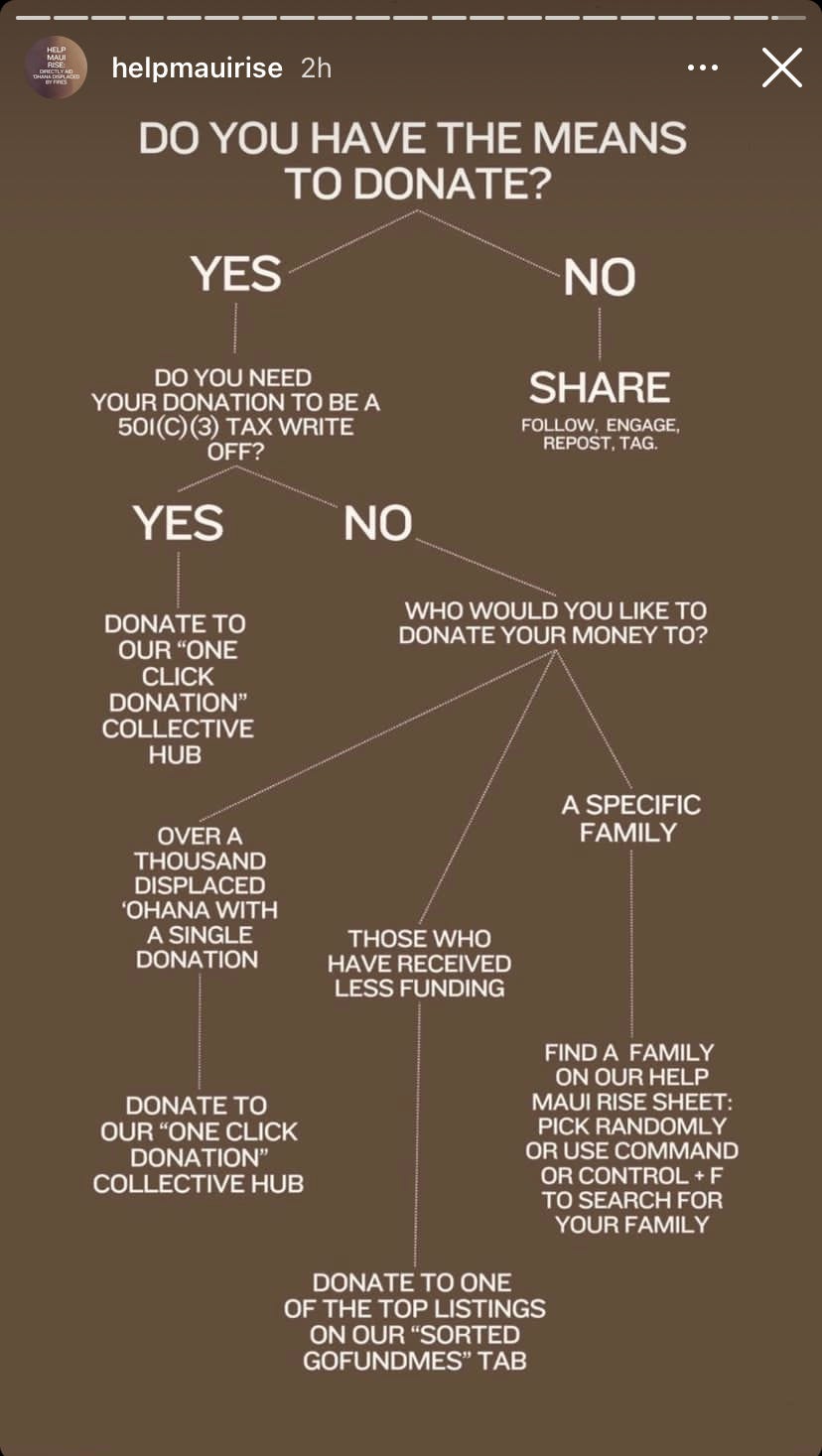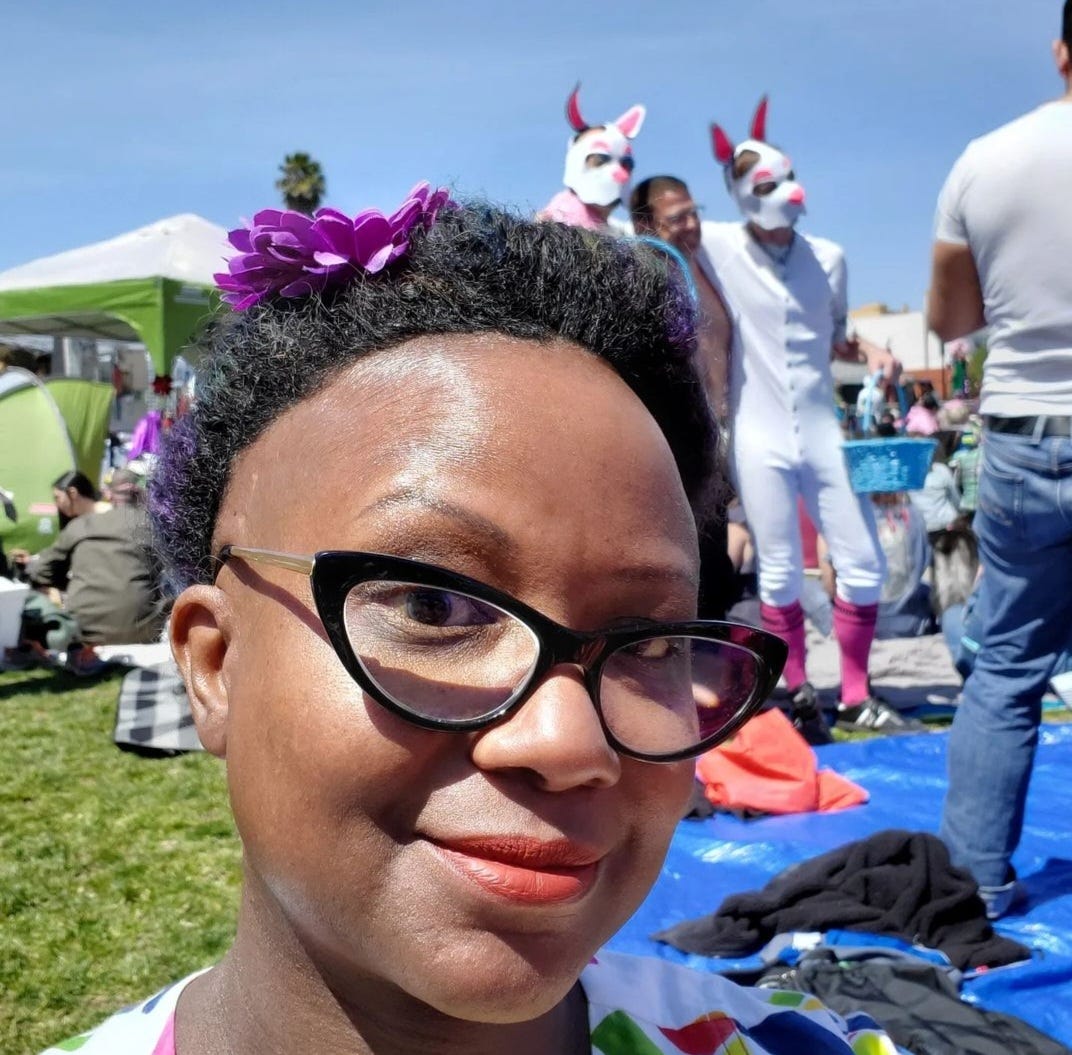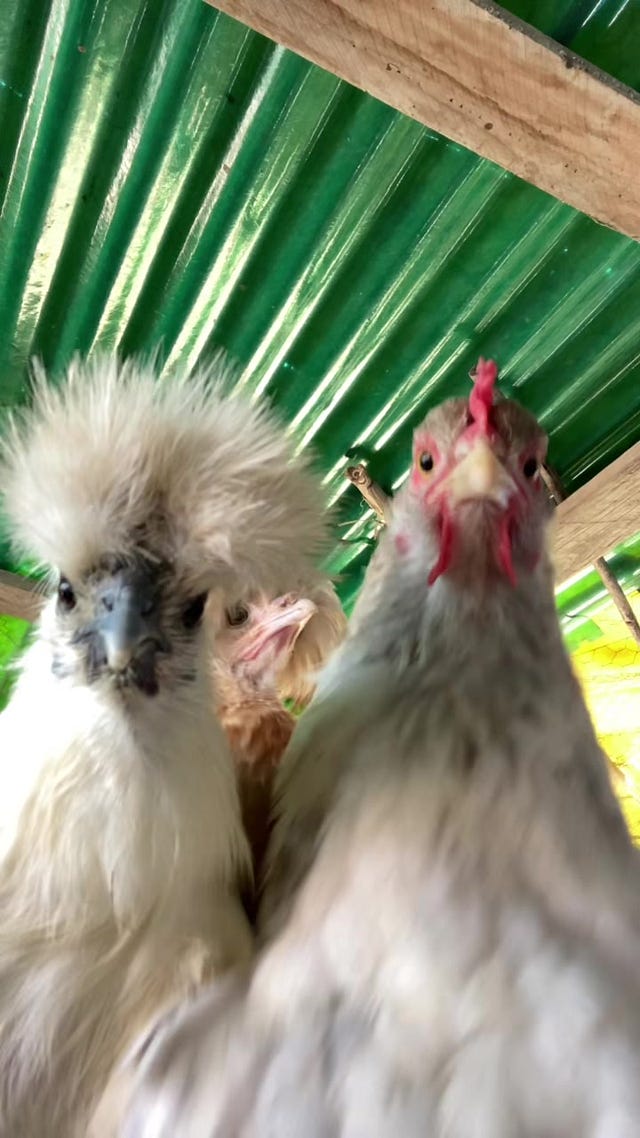Volume 23
Continue supporting Maui; Part 1 of a two-part interview with death cleaner Courtney King; at-home resources to start thinking about death.
ACTION ITEMS
MAUI UPDATES
It has been a little over a month since the devastating fires ripped through Lahaina and Kula. The ‘official’ death toll of the Lahiana fires stands at 115 with 60 bodies identified. However, this seems to be a gross underestimation of the total lives lost.
The grief remains heavy.
For real-time updates and opportunities to give directly to the community, we recommend following and continuing to share the work of @helpmauirise. The incredible women who created the spreadsheet we mentioned in our previous newsletter have maintained their momentum and recently partnered with Gofundme to create a method of ensuring equal distribution of funds between the 1100+ gofundmes listed in the spreadsheet (that is still constantly being updated). From the ‘About’ section on their website:
Welcome to the Help Maui Rise website; home of the spreadsheet you may have seen circulating that houses the stories of families displaced by the Maui Wildfires. What started out as a simple Google sheet to share within our inner circles has evolved into a growing resource of over a thousand affected loved ones, all vetted by our team and reviewed by GoFundMe directly.
In Hawai'i, community is everything, and when the fires began on August 8th, we knew we needed to take action. As three community members, our only wish is to provide aid to the displaced 'ohana of Lāhainā & Kula as quickly and directly as possible. The Maui fires took nearly 3,000 homes and businesses. 115 people have been confirmed dead and nearly three weeks later, hundreds are still unaccounted for. Families were given no warning and sometimes only seconds to escape, many of them with only the clothes on their backs.
Maui needs us now more than ever. The money you donate will help the displaced families of Lāhainā & Kula to get back on their feet and rise from the ashes. Our website offers multiple ways to donate.
Click Help Maui Rise to access the original google sheet with direct ways to donate to over 1,100 families.
Click Sorted GoFundMes to access individual fundraisers sorted from lowest funded to highest to directly donate to the families that need you most.
Click One Click Donation to access our collective hub where you can donate to all the gofundme links with a single tax deductible 501(3)(c) donation.
Whether you are from Hawai'i, have visited our island home, or are just learning about this from the news, we humbly ask for your kāko'o (support).
Mahalo nui loa,
The Help Maui Rise team
FOOD FOR THOUGHT
Eliana and I took a summer hiatus from CDD things and didn’t really mention it to anyone, and it was so necessary. We feel rejuvenated and are excited for all future things for CDD. We are grateful to our readers, supporters and contributors. We continue this labor of love because we believe in creating this record. A record of all the people doing deathcare in all the various loving ways. A record of how we take care of us despite all the systems that fail us daily. A record and an inquiry into how we do community deathcare together.
This Volume’s Food for Thought is an interview with professional organizer and death cleaner, Courtney King. You can find Courtney’s website here and their instagram here. Courtney and I met as student guides with the Going with Grace end-of-life training course back in 2022. I am so excited to finally share this conversation we had back at the end of May. Because we want to share as much of this nourishing conversation as possible, we are making this conversation I had with Courtney a two-part interview.
- Resham Mantri
“It’s ok if the wheels fall off…”
Part 1 of a two-part interview with death cleaner, Courtney King.
Resham
How did you come to death cleaning ?
Courtney
I came to a death cleaning through being a professional organizer. I've been an organizer for 10 years. Let's see, my first death cleaning was probably like 2014, so yeah.
I started as a professional organizer in 2009. Professional organizing is this huge field that has different specialties and different niches. Some people specialize in offices, some people do wardrobe. I wound up working with elders a lot, who were downsizing. Either downsizing because they were being brought into their adult children's home or because they were moving into some sort of managed complex, be it a senior care facility or assisted living with medical facilities. Other times I wound up organizing where they were trying to age in place, but needed the space rearranged in order to support medical personnel and equipment in their space.
A lot of the emotions that come up for elders in that situation are tied to reckoning with their life, legacy, mortality, identity, and relationships. As I was working with elders in these different situations, they started to die. So then you get contacted again, like, Hey, can you help with the move out? Or can you help with shutting this down completely? Can you help with distributing these things? So that was a natural progression of organizing.
And I got to like it. It felt right. It felt good. I was called by other organizers who were like, “oh, somebody died and I don't know what to say.” And it's like, okay, yeah, I can come do this.
Resham
I love that journey.
You’re working on this writing project and I want to ask you about this difference we have spoken about before, between the “knowing” and the “doing” in our culture. In writing about what we do, how do you guide people when you know that a lot of the times they just need be in the doing ? I feel that same tension when I write or when I talk to clients and I’m wondering if you have any thoughts about it.
Courtney
It's to be honest about how messy it is. I think again about the expectation that if you have a guide, that guide means you won't fail. I think that is not the point of having a guide. That failure is not quite the lens that's appropriate.
I'll give an example that hit me outta the blue. One idea from working with people with hoarding behaviors is, depending on what the situation is, you don't want the client to touch anything as you're working, because they will immediately fixate and fall down a hole and whatever momentum you've got, whatever focus they have, is gone. And trying to get them to make decisions about anything or have a conversation about what sort of progress they want? No, it's about the thing that they are literally physically connected to in that moment and the stories that they have about that.
When I was shutting down my grandfather's home, I was touching the items, and as I was packing up the fancy dishes, I was tasting the meals that I'd eaten off of them. I picked up a random tchotchke out of the China cabinet, and the sensation of the pricking on my palm sent me into a full-fledged flashback where I was four years old on my knees, in their house, in the living room, the house on Maryland Street, playing at a coffee table with this object. And I had played with that thing for a complete afternoon. Like the sun moved through the living room and I like could hear the adults around the corner, after dinner I could hear glasses clinking.
I put the thing down and I was exhausted. I felt like I had played for 3-4 hours. About 30 seconds had passed. My focus, my momentum, my ability to brain was gone, I had to sit down for a minute. And again, this is why we tell people don't touch things. And I had the benefit of having a positive flashback/ memories. If I'm working with a client, I don't know if their memories are positive or negative or like straight up traumatic. There are landmines lurking out there. So instead of saying, Don’t touch the thing. You can tell them, “You understand that this is out there and it can derail you and get messy.” “So what things do you know that you can do to ground yourself?”
“What are things that you can bring you back into yourself and help you feel resourced in some sort of way?” “If you see me glaze over, try number one on the list. If you see me get twitchy, try number three on the list. In addition to doing the, “this is the order that you pack things in, these are the boxes that you use”, also having things that acknowledge the ways in which stuff gets derailed.
Courtney
I say that our jobs, death workers, organizers, a lot of jobs in the modern world are outsourcing the role of community. Extended community, deep, vibrant community. The not being alone part is almost like a luxury now.
It's like, oh, you want community. Here, pay for it.
Resham
Yeah. That is so true. And also so dark about the culture we live in.
In a lot of places, you're right, our roles do not need to exist because the elderly, for example, don't go to nursing homes, they live with their families. The whole community, the whole country and society is built off of this notion of community. It’s a bit sad being in a job that literally exists because of that. But then I think part of what we get to do is tell people how we can do this work for each other.
Courtney
I posted a video from TikTok, a woman talking about the, prevalence of people living alone in modern culture and how the perfect consumer is a single person household because they have to purchase all of the things that come from being in community. So the more stripped back you can make a person, the more isolated you can make a person, the better a consumer they are. The more community they have, the less things they have to go out and search for.
OFFERINGS WE LOVE
Two resources to start thinking about how to plan for dying for either yourself or a loved one.
The Mortality Workbook from The Death Project Manager.
“Short on time? Process information better in printed form? Want to focus on the essentials? Go the DIY route with the Death Project Manager zine! Our Mortality Workbook has 40+ pages to organize your contacts, collect your documents, reflect on your values, and create a plan in case of emergency.”
Going with Grace’s Guide to Completion
“This e-workbook contains the vital information to support you in completing the affairs of your love one’s life. It can also be used to support you prior to the death of someone you care for to ensure that you’ve handled the necessary tasks while they are still living.” - Going with Grace
SIMPLE PLEASURES
Mother/son wedding dance choreography is true love
A better way to ‘bus’ to school
Moth mother shares her story of falling in love
Sha’Carri Jackson remains the GOAT
 Tiktok failed to load.
Tiktok failed to load.Enable 3rd party cookies or use another browser



